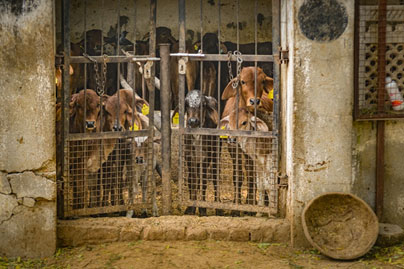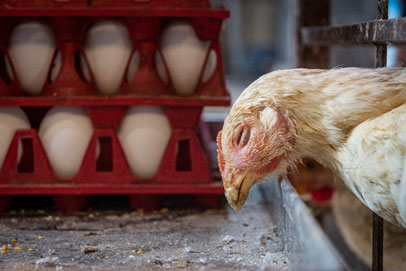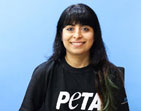Hens too suffer in the egg industry. They are forced to live in cages so small they can’t even spread a wing. The farmers slice off a portion of their beaks with a hot blade since they peck each other from the misery of intense confinement. Through breeding and manipulation of their bodies, these creatures are made to lay far more eggs than natural which deplete their calcium, resulting in brittle and fragile bones that break easily.
They endure this kind of suffering in captivity, covered in each other’s faeces, until their bodies give out and they are taken away to be butchered. Just like Ahimsa dairy, don’t be fooled by free-range eggs. They are also typically kept in severely crowded conditions and their journey brutally ends under a knife.
With increased awareness of such cruelty and the impact of the production of animal-derived foods on the environment, many vegetarians are going vegan. Dietary vegans are vegetarians who are also dairy and egg free.
But being vegan is ultimately about actually leading a vegan lifestyle. If we’re wearing the product of slaughter on our feet, we can hardly be said to be living a genuinely ahimsak life. Cows and buffaloes’ skin turned into bags and shoes often just comes from babies. With hardly any flesh on their bones, their lives are snuffed out for their soft skins. In slaughterhouses in India, butchers slit the throats of these babies and other cows or buffaloes while they’re still conscious in front of other animals. And for what? A belt?
As with “Ahimsa milk”, be sure to question claims about “Ahimsa leather”, which sellers assert comes from cows who had natural deaths. Cows who die from natural causes quickly decompose, so maintaining a supply of their skins for items to sell would be an enormous challenge. Also, to keep leather from rotting on your feet, most animal skin is treated with extremely harsh chemicals, usually chromium, a carcinogen. That’s why so many tannery workers die prematurely.
True Ahimsa leather is vegan leather, which these days is increasingly made from plants – often agricultural waste. The good news is that vegan footwear, bags, and other products are widely available just about anywhere one shops. All you have to do is read labels and put anything containing animal leather back on the rack.
Living by the principle of Ahimsa also means avoiding products tested on animals. Animal testing is a horror. Dubious, unethical experiments involve injecting dogs with poisons and forcing monkeys to inhale harsh chemicals. Experimenters rub toxic substances into the eyes or raw skin of rabbits, just so that the latest shampoo or lipstick can be launched.
But there is a kinder way. Following efforts by PETA India, our nation has banned the testing of various household products, cosmetics, and their ingredients on animals. But to be sure you aren’t buying products from companies which test on animals anywhere in the world, use the Beauty Without Bunnies database found on PETAIndia.com.
And if you are non-violent in your food and other consumer choices, be non-violent in your entertainment choices, too. Entertainment involving the suffering of animals is also not in line with a humane lifestyle. We don’t need animal circuses, horse carriages, aquariums, elephant rides, and so on. We can let animals live free in their natural homes in forests or the sea and amuse ourselves instead through books, films, human-only sports, or other activities that exemplify Ahimsa.




